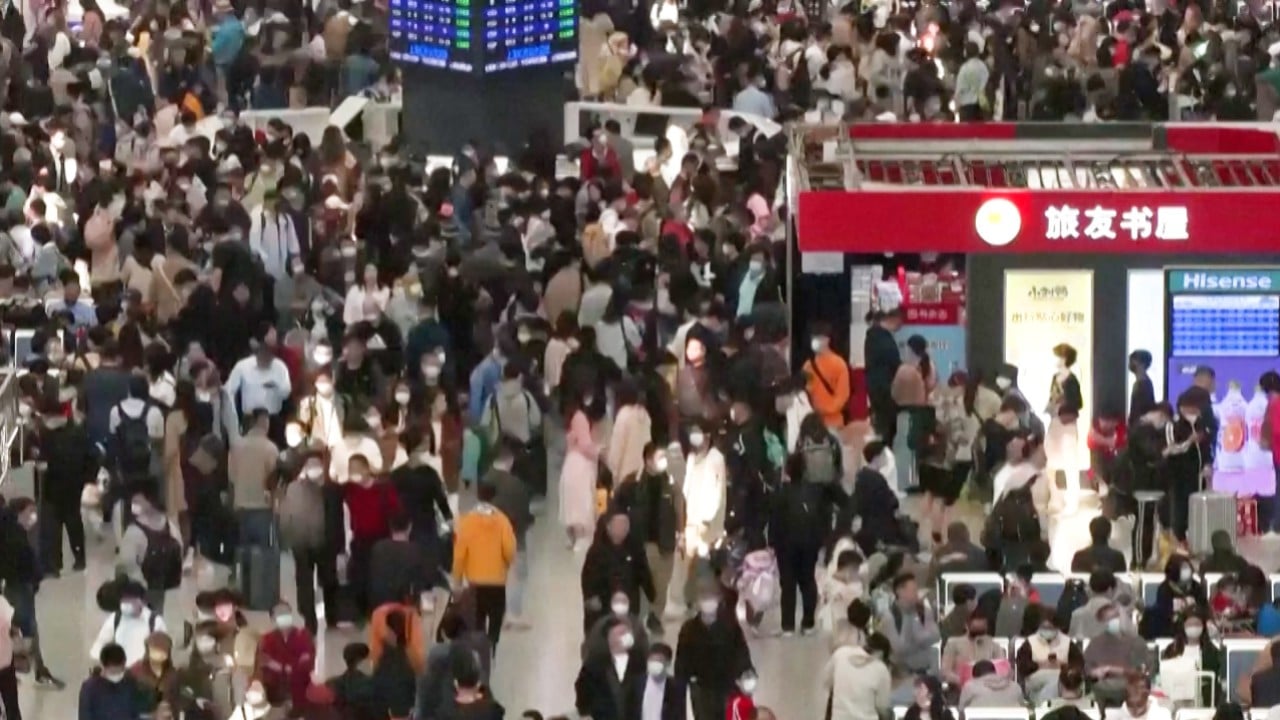
02:17
Thousands of tourists flock to China’s Great Wall during ‘golden week’, as travel numbers rebound
China’s consumers spend US$21 billion during May Day holiday, but easy part of economic recovery ‘is done’
- Domestic tourism revenues jumped to 101 per cent of pre-pandemic levels, reaching 148 billion yuan (US$21.4 billion), during the five-day ‘golden week’ holiday
- Around 274 million people travelled over the Labour Day or May Day holiday, but the ‘easy part of China’s post-reopening recovery is done’, analysts said
China’s services sector enjoyed a long-awaited recovery in consumer spending over the five-day “golden week” holiday, with the level of domestic tourism revenue exceeding 2019 levels for the first time since the start of the coronavirus pandemic.
But after domestic tourism revenues jumped to 101 per cent of pre-pandemic levels, reaching 148 billion yuan (US$21.4 billion), analysts warned the explosion of pent-up demand might not be sustainable, with the next leg of the economic recovery set to be more arduous.
Around 274 million people travelled over the Labour Day or May Day holiday, which concluded on Wednesday, with the figure reaching 119 per cent of pre-pandemic levels in 2019, according to the Ministry of Culture and Tourism, as tourists flocked to attractions after China lifted its last remaining virus restrictions at the start of the year.
“The strong Labour Day holiday tourism data, together with the still-solid April services [purchasing managers’ index], bode well for consumption and services recovery in coming months, despite the softening in manufacturing growth momentum,” Goldman Sachs said on Thursday.
The next leg of consumption recovery will rely on higher income growth and improved consumer confidence, which will make the recovery model more sustainable
“However, we believe the easy part of China’s post-reopening recovery – which includes the full recovery of mobility and the release of pent-up demand in select sectors – is done,” Goldman Sachs added.
“The next leg of consumption recovery will rely on higher income growth and improved consumer confidence, which will make the recovery model more sustainable.
According to online travel agency Trip.com, the number of domestic tourist attraction tickets sold during the five-day holiday was nine times higher compared to last year, and more than double the pre-pandemic level in 2019.
As one of the first major holidays since China dropped its inbound quarantine requirements, the number of tourists travelling abroad also reached a peak for the last three years, according to Trip.com.
The average price of an outbound flight ticket was 2,104 yuan (US$304) during the holiday, around a third higher than in 2019 as demand outstripped the supply of seats, the online travel agency added.
The fact that domestic tourism spending is now back to 2019 levels suggests that the reopening boost to consumer spending has largely run its course
The number of outbound travel bookings skyrocketed by nearly 700 per cent compared to the same period last year, while the number of flight ticket bookings rose by nearly 900 per cent, and hotel bookings by nearly 450 per cent, according to Trip.com.
But despite the strong rebound going on in the service sector, the recovery will become more challenging going forward, analysts said.
“The fact that domestic tourism spending is now back to 2019 levels suggests that the reopening boost to consumer spending has largely run its course,” Capital Economics said on Thursday.
“The manufacturing sector also faces challenges from the weak global outlook. As such, the recovery is likely to continue to lose momentum over the coming months.”
This was the lowest level since China’s post-pandemic reopening late last year as the subindex to measure new orders dipped to 48.8 from 53.6, indicating decline in market demand.
Another index to gauge new export orders also fell to its lowest level in three months after dropping to 47.6 from 50.4 in March.
“The latest survey data add to wider evidence that while China’s recovery remains robust, it is losing some momentum,” added Capital Economics.
“In particular, the manufacturing PMIs fell below 50, suggesting that the reopening boost to industry has fizzled out. And although the services recovery is still going strong, we don’t think this momentum will be sustained for long.”
Momentum is slowing relative to what was achieved in the first quarter. And the recovery will become more challenging going forward
But retail sales, investment and industrial output data for March showed that the recovery remains uneven, while employment pressure remains.
“The latest survey readings are consistent with still rapid growth at the start of the second quarter. But momentum is slowing relative to what was achieved in the first quarter. And the recovery will become more challenging going forward,” said Capital Economics.

